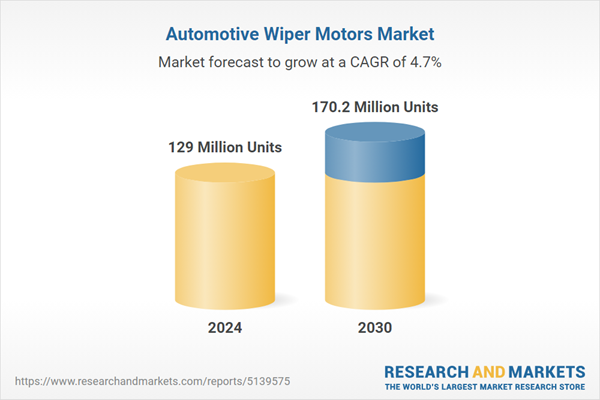The global market for Automotive Wiper Motors was sized at 129.0 Million Units in 2024 and is projected to reach 170.2 Million Units by 2030, growing at a CAGR of 4.7% over the analysis period 2024-2030. This comprehensive report provides an in-depth analysis of market trends, drivers, and forecasts, helping you make informed business decisions.
Global Automotive Wiper Motors Market - Key Trends and Drivers Summarized
Why Are Automotive Wiper Motors More Crucial Than Ever?
Automotive wiper motors are an essential component of any vehicle, yet their role often goes unnoticed until adverse weather conditions put them to the test. These motors are responsible for driving the wiper blades across the windshield, ensuring clear visibility in rain, snow, or dust. The evolution of wiper motors from simple mechanical systems to sophisticated electronic components reflects the broader trends in the automotive industry, where precision, efficiency, and reliability are paramount. As vehicles become more advanced, the demand for wiper motors that can integrate with complex electronic systems, such as rain sensors and advanced driver assistance systems (ADAS), has increased. These advancements require wiper motors that not only perform their primary function efficiently but also do so with minimal noise and energy consumption, catering to the high expectations of modern consumers and regulators.What Are The Innovations Driving Wiper Motor Advancements?
The automotive industry is witnessing a surge in innovation, and wiper motors are no exception. Recent advancements in motor design and technology have led to the development of wiper motors that are more compact, efficient, and powerful. These innovations include the integration of smart sensors that adjust wiper speed based on real-time weather conditions and the development of motors that operate more quietly to meet consumer demand for a quieter driving experience. Moreover, as electric and hybrid vehicles gain popularity, there is a growing need for wiper motors that are lightweight and consume less power, aligning with the overall goal of energy efficiency in modern vehicles. Additionally, the trend towards modular vehicle architecture has opened up new possibilities for customizable wiper motor systems that can be tailored to specific vehicle designs and performance requirements, further pushing the envelope of what wiper motors can achieve.How Do Regulatory Pressures Influence Wiper Motor Development?
Regulatory bodies around the world are increasingly focused on vehicle safety and environmental impact, and these regulations are influencing the development of automotive wiper motors. For instance, regulations that mandate enhanced visibility in all weather conditions have driven the demand for high-torque wiper motors that can perform effectively even in the harshest conditions. Similarly, noise pollution standards have led to innovations in motor design that reduce operational noise, addressing both regulatory and consumer concerns. The push for greater vehicle efficiency has also prompted manufacturers to develop motors that are more energy-efficient, contributing to overall fuel savings and reduced emissions. These regulatory pressures are not only shaping the technical specifications of wiper motors but are also driving the adoption of new materials and manufacturing processes that are more sustainable and environmentally friendly.What Is Fueling The Growth Of The Automotive Wiper Motor Market?
The growth in the automotive wiper motor market is driven by several factors, including the increasing adoption of electric and hybrid vehicles, the rising demand for advanced driver assistance systems (ADAS), and the growing emphasis on vehicle safety and comfort. As electric and hybrid vehicles become more prevalent, the need for lightweight, energy-efficient wiper motors that align with the overall goals of these vehicles is becoming increasingly important. Furthermore, the integration of ADAS and other smart vehicle technologies is driving the demand for wiper motors that can seamlessly interact with these systems, offering automated and adaptive functionalities. Consumer preferences are also shifting towards vehicles that offer a quieter and more comfortable driving experience, leading to innovations in noise reduction and motor efficiency. Additionally, the trend towards customizable and modular vehicle designs is creating new opportunities for manufacturers to develop wiper motors that meet the specific needs of different vehicle models. Together, these factors are not only expanding the market for automotive wiper motors but also pushing the boundaries of what these systems can achieve in terms of performance and reliability.Report Scope
The report analyzes the Automotive Wiper Motors market, presented in terms of market value (US$ Thousand). The analysis covers the key segments and geographic regions outlined below.Segments
Segment (Automotive Wiper Motors).Geographic Regions/Countries
World; United States; Canada; Japan; China; Europe (France; Germany; Italy; United Kingdom; Spain; Russia; and Rest of Europe); Asia-Pacific (Australia; India; South Korea; and Rest of Asia-Pacific); Latin America (Argentina; Brazil; Mexico; and Rest of Latin America); Middle East (Iran; Israel; Saudi Arabia; United Arab Emirates; and Rest of Middle East); and Africa.Regional Analysis
Gain insights into the U.S. market, valued at 33.7 Million Units in 2024, and China, forecasted to grow at an impressive 7.5% CAGR to reach 37.9 Million Units by 2030. Discover growth trends in other key regions, including Japan, Canada, Germany, and the Asia-Pacific.Report Features:
- Comprehensive Market Data: Independent analysis of annual sales and market forecasts in US$ Million from 2024 to 2030.
- In-Depth Regional Analysis: Detailed insights into key markets, including the U.S., China, Japan, Canada, Europe, Asia-Pacific, Latin America, Middle East, and Africa.
- Company Profiles: Coverage of major players such as ACDelco, Bosch Rexroth Corporation, Canadian Tire Corp., Ltd., Cardone Industries, Inc., Commercial Vehicle Group, Inc. and more.
- Complimentary Updates: Receive free report updates for one year to keep you informed of the latest market developments.
Why You Should Buy This Report:
- Detailed Market Analysis: Access a thorough analysis of the Global Automotive Wiper Motors Market, covering all major geographic regions and market segments.
- Competitive Insights: Get an overview of the competitive landscape, including the market presence of major players across different geographies.
- Future Trends and Drivers: Understand the key trends and drivers shaping the future of the Global Automotive Wiper Motors Market.
- Actionable Insights: Benefit from actionable insights that can help you identify new revenue opportunities and make strategic business decisions.
Key Questions Answered:
- How is the Global Automotive Wiper Motors Market expected to evolve by 2030?
- What are the main drivers and restraints affecting the market?
- Which market segments will grow the most over the forecast period?
- How will market shares for different regions and segments change by 2030?
- Who are the leading players in the market, and what are their prospects?
Some of the 41 major companies featured in this Automotive Wiper Motors market report include:
- ACDelco
- Bosch Rexroth Corporation
- Canadian Tire Corp., Ltd.
- Cardone Industries, Inc.
- Commercial Vehicle Group, Inc.
- Denso Corporation
- Euro Car Parts Limited
- Ford Motor Company (Ford Parts)
- Johnson Electric Holdings Limited
- KOLLMORGEN Europe GmbH
Table of Contents
I. METHODOLOGYII. EXECUTIVE SUMMARY2. FOCUS ON SELECT PLAYERSIII. MARKET ANALYSISIV. COMPETITION
1. MARKET OVERVIEW
3. MARKET TRENDS & DRIVERS
4. GLOBAL MARKET PERSPECTIVE
UNITED STATES
CANADA
JAPAN
CHINA
EUROPE
FRANCE
GERMANY
ITALY
UNITED KINGDOM
SPAIN
RUSSIA
REST OF EUROPE
ASIA-PACIFIC
AUSTRALIA
INDIA
SOUTH KOREA
REST OF ASIA-PACIFIC
LATIN AMERICA
ARGENTINA
BRAZIL
MEXICO
REST OF LATIN AMERICA
MIDDLE EAST
IRAN
ISRAEL
SAUDI ARABIA
UNITED ARAB EMIRATES
REST OF MIDDLE EAST
AFRICA
Companies Mentioned (Partial List)
A selection of companies mentioned in this report includes, but is not limited to:
- ACDelco
- Bosch Rexroth Corporation
- Canadian Tire Corp., Ltd.
- Cardone Industries, Inc.
- Commercial Vehicle Group, Inc.
- Denso Corporation
- Euro Car Parts Limited
- Ford Motor Company (Ford Parts)
- Johnson Electric Holdings Limited
- KOLLMORGEN Europe GmbH
Table Information
| Report Attribute | Details |
|---|---|
| No. of Pages | 194 |
| Published | April 2025 |
| Forecast Period | 2024 - 2030 |
| Estimated Market Value in 2024 | 129 Million Units |
| Forecasted Market Value by 2030 | 170.2 Million Units |
| Compound Annual Growth Rate | 4.7% |
| Regions Covered | Global |









